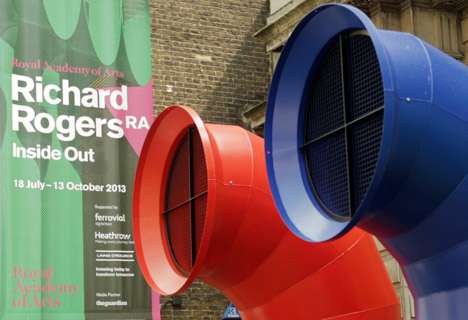In the first of a series of exclusive video interviews with Richard Rogers, the British architect discusses the themes of his Royal Academy of Arts retrospective and explains why a building should not just be designed for a specific client, but society as a whole.

Speaking at Rogers Stirk Harbour + Partners' Thames-side offices in west London, Rogers explains that the exhibition at the Royal Academy of Arts in London is not meant to simply be a showcase of his work.
"The Royal Academy asked whether I would like to do an exhibition about my life, not specifically about my work," he says. "[It is] more about the thinking and also a section through 80 years of life."

The key theme of the exhibition, Rogers explains, is social responsibility.
"We've decided to call the exhibition Inside Out, partly because I often put structure and ducts on the outside of buildings," he says.

"But the real title is Ethos. The idea is that we have a responsibility to society. And that gives us a role as architects that is more than just answering the client but also to answer the passerby and society as a whole."
Greeting visitors in large letters on the wall of the first room in the exhibition is a quotation that reads: "A place for all people, the young and the old, the poor and the rich."
Rogers explains that this was the first paragraph that he wrote with Italian architect Renzo Piano when they were preparing their competition entry for the Centre Pompidou in Paris, which would go on to become one of Rogers' most famous buildings.
"It shows the heart of this exhibition because that gave us the way of handling the Pompidou not just as a building, but also as a place, which I'm much more interested in," Rogers says.
In this room there is also a video projected on the wall, in which Rogers explains his concept of "ethos".
"It's based funnily enough on my mother's watch, which I always wear," Rogers says."It is a Bulova, which has beautiful workings in it. It's some 50 years old now, and [the video] sort of explains my work through that watch."
On the wall of the exhibition's final room is another quotation, a translation of an oath that young men of ancient Athens had to swear before becoming full citizens: "I shall leave this city not less but more beautiful than I found it".
"It is an oath which I would like to think we are all trying to do," says Rogers. "Using beauty in that very broad, shall we say Greek way: democratic and intellectual, not just purely aesthetic."
Rogers goes on to explain that he believes that good architecture is the result of teamwork, rather than one person's vision.
"I work very much with colleagues, with friends," he says. "Architecture is about teams. The idea that you suddenly wake up and do a sketch is not true. The only time I do that, I usually wake up with a hangover the next morning."
He continues: "Like any work, whether film or book, [architecture] has its own inertia, it changes direction. And also the scale changes. The scale in your mind, the scale in models slowly gets more and more attuned to what you're actually doing. You can't imagine a building as complete any more than you can imagine 500 pages [of a book]."
The exhibition also features a number of personal items, including a report card from Rogers' fourth year as a student at the Architectural Association School of Architecture, which doubts his ability to succeed as an architect.
"Rogers' late entry into the 4th Year was not successful," reads the report. "He has a genuine interest in and a feeling for architecture, but sorely lacks the intellectual equipment to translate these feelings into sound building."
The report continues: "His designs will continue to suffer while his drawing is so bad, his method of work so chaotic and his critical judgement so inarticulate."
"I was an appalling student, all my life," admits Rogers, who was later diagnosed as suffering from dyslexia. "In fact, I enjoyed myself much more in the last third of my life than I did in my first third."
"Everybody said I was stupid and then I found out that actually I had learning difficulties. So those gave me a lot of problems for the first thirty years. But the last 30 years of my life have been fantastic."
Richard Rogers RA: Inside Out exhibition runs from 18 July to 13 October 2013 at the Royal Academy of Arts in London.
See our earlier story about the exhibition »
The London home designed by Rogers for his parents, and which influenced his later design for the Pompidou Centre, was recently put on the market for the first time since it was built in 1968.
Read the full story about Rogers House »
See all our stories about Richard Rogers »
